oil change BUICK PARK AVENUE 1994 Owners Manual
[x] Cancel search | Manufacturer: BUICK, Model Year: 1994, Model line: PARK AVENUE, Model: BUICK PARK AVENUE 1994Pages: 324, PDF Size: 17.01 MB
Page 129 of 324
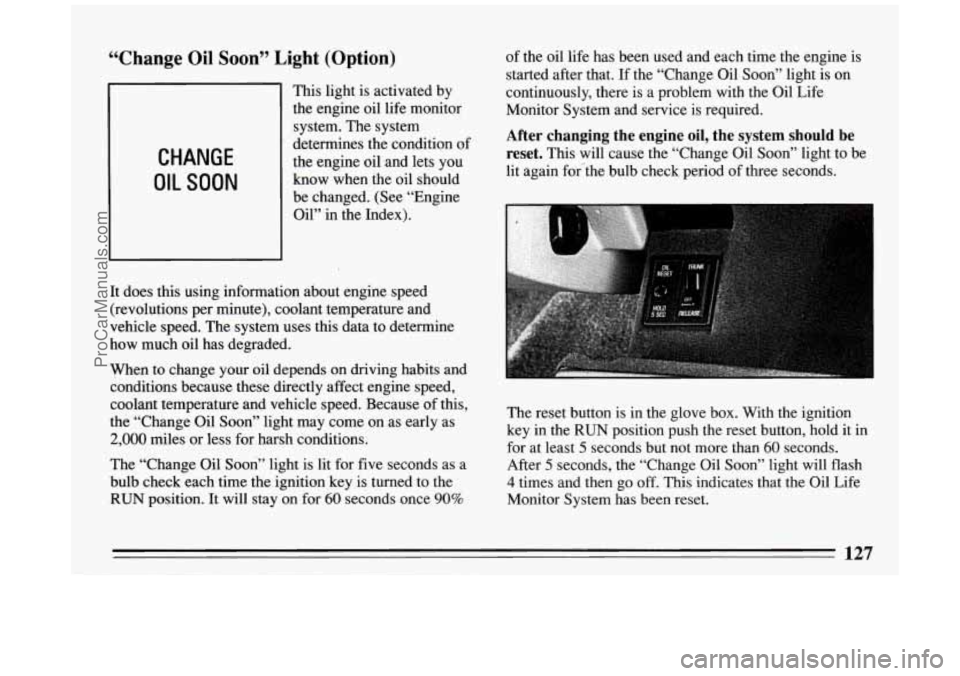
“Change Oil Soon” Light (Option)
CHANGE
OIL SOON
This light is activated by
the engine oil life monitor
system. The system
determines the condition
o
the engine oil and lets you
know when the oil should
be changed. (See “Engine
Oil” in the Index).
It does this using information about engine speed (revolutions per minute), coolant temperature and
vehicle speed. The system uses this data to determine
how much oil has degraded. of
the oil life has been used and each time the engine is
started after that.
If the “Change Oil Soon” light is on
continuously, there is a problem with the Oil Life
Monitor System and service is required.
After changing the engine oil, the system should be
reset.
This will cause the “Change Oil Soon” light to be
lit again for#the bulb check period
of three seconds.
When to change your oil depends on driving habits and
conditions because these directly affect engine speed,
coolant temperature and vehicle speed. Because of this,
the “Change Oil Soon” light may come on as early as
2,000 miles or less for harsh conditions.
The “Change Oil
Soon” light is lit for five seconds as a
bulb check each time the ignition key is turned to the
RUN position. It will stay on for 60 seconds once 90%
f
The reset button is in the glove box. With the ignition
key in the
RUN position push the reset button, hold it in
for at least
5 seconds but not more than 60 seconds.
After
5 seconds, the “Change Oil Soon” light will flash
4 times and then go off. This indicates that the Oil Life
Monitor System has been reset.
127
ProCarManuals.com
Page 243 of 324

As shown in the chart, SAE 1OW-30 is best for your
.vehicle. However, you can use SAE 5W-30
if it’s going
to be colder than
60°F (16°C) before your next oil
change. When it’s very cold, you should use
SAE
5W-30. These numbers on an oil container show its
viscosity, or thickness. Do not use other viscosity oils,
such as SAE 1OW-40 or SAE 2OW-50.
If you cannot find oils
with the new “starburst” symbol
on the front
of the container, you should look for and
use
oils containing the following three things:
0
0
0
SH or SG
“SH” or “SG” must be on the oil container, either by
itself or combined with other quality designations,
such as “SH/CD,” “SH,SG,CD,”
“SG/CD” etc.
These letters show American Petroleum Institute
(API) levels of quality.
SAE 1OW-30
Energy Conserving I1
Oils
with these words on the container will help you
save fuel. These
three things are usually included
in a doughnut
shaped logo (symbol) on most containers. If you cannot
find oils
with the “starburst” symbol, you should look
for oils
with the doughnut shaped symbol, containing
the three things noted above.
NOTICE:
If you use oils that do not have either the
“starburst” symbol or an
API SH or SG
designation, you can cause engine damage not
covered by your warranty.
GM Goodwrench@ oil (in Canada, GM Engine Oil)
meets all the requirements for your vehicle.
241
ProCarManuals.com
Page 244 of 324

Engine Oil Additives
Don’t add anything to your oil. Your Buick dealer is
ready to advise if you think something should be added.
When to Change Engine Oil
See if any one of these is true for you:
Most trips are less than 4 miles (6 km).
It’s below freezing outside and most trips are less
than
10 miles (16 km).
The engine is at low speed most of the time (as in
door-to-door delivery, or in stop-and-go traffic).
0 You tow a trailer often.
Most trips are through dusty places.
If any one of these is true for your vehicle, then you
need to change your oil and filter every
3,000 miles
(5 000 km) or 3 months -- whichever comes first. (See
“Change Oil Soon” in the Index.) If
none of
them is true, change the oil every 7,500 miles
(12 500 km) or 12 months -- whichever comes first.
Change the filter at the first oil change and at every
other oil change after that.
If the optional “Change Oil Soon” light comes on you
will need to change your oil sooner than either mileage
specified. Depending upon driving habits, the “Change
Oil Soon’’ light may come on
as early as 2,000 miles or
less from the last time the oil life monitor was reset (See
“Oil Life Monitor” in the Index.)
Always reset the oil
life monitor after every oil change.
Engine Coolant Heater (Engine Block
Heater)
An engine coolant heater can be a big help if you have
to park outside in very cold weather,
0°F (- 18 “C) or
colder. If your vehicle has this option, see “Engine
Coolant Heater” in the Index.
242
ProCarManuals.com
Page 245 of 324
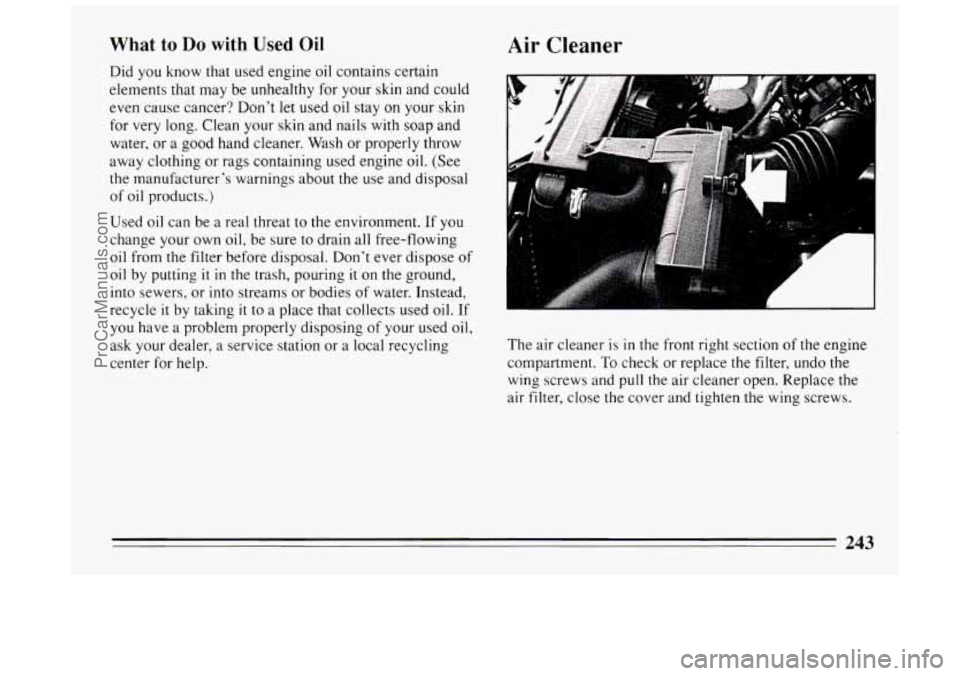
What to Do with Used Oil
Did you know that used engine oil contains certain
elements
that may be unhealthy for your skin and could
even cause cancer? Don’t let used oil stay on your skin
for very long. Clean your skin and nails with soap and
water, or a good hand cleaner. Wash or properly throw
away clothing or rags containing used engine oil. (See
the manufacturer’s warnings about the use and disposal
of oil products.)
Used oil can be a real threat to the environment. If you
change your own
oil, be sure to drain all free-flowing
oil from the filter before disposal. Don’t ever dispose of
oil by putting it in the trash, pouring
it on the ground,
into sewers, or into streams or bodies of water. Instead,
recycle it by taking
it to a place that collects used oil. If
you have a problem properly disposing of your used oil,
ask your dealer, a service station or a local recycling
center for help.
Air Cleaner
1
The air cleaner is in the front right section of the engine
compartment.
To check or replace the filter, undo the
wing screws and pull the air cleaner open. Replace the
air filter, close
the cover and tighten the wing screws.
243
ProCarManuals.com
Page 246 of 324

Refer to the Maintenance Schedule to determine when
to replace the air filter.
See “Scheduled Maintenance Services”
in the Index.
NOTICE:
If the air cleaner is off, a backfire can cause a
damaging engine fire. And, dirt can easily get
into your engine, which will damage
it. Always
have the air cleaner
in place when you’re driving.
Automatic Transaxle Fluid
When to- Check and Change
A good time to check your automatic transaxle fluid
level is when the engine oil is changed. Refer
to the
Maintenance Schedule to determine when to change
your fluid. See “Scheduled Maintenance Services’’ in
the Index.
How to Check
Because this operation can be a little difficult, you may
choose
to have this done at a Buick dealership Service
Department.
If you do it yourself, be sure to follow all the
instructions here, or you could get a false reading
on the
dipstick.
NOTICE:
Too much or too little fluid can damage your
transaxle.
Too much can mean that some of the
fluid could come out and fall on hot engine parts
or exhaust system, starting a fire. Be sure
to get
an accurate reading if you check your transaxle
fluid.
244
ProCarManuals.com
Page 284 of 324
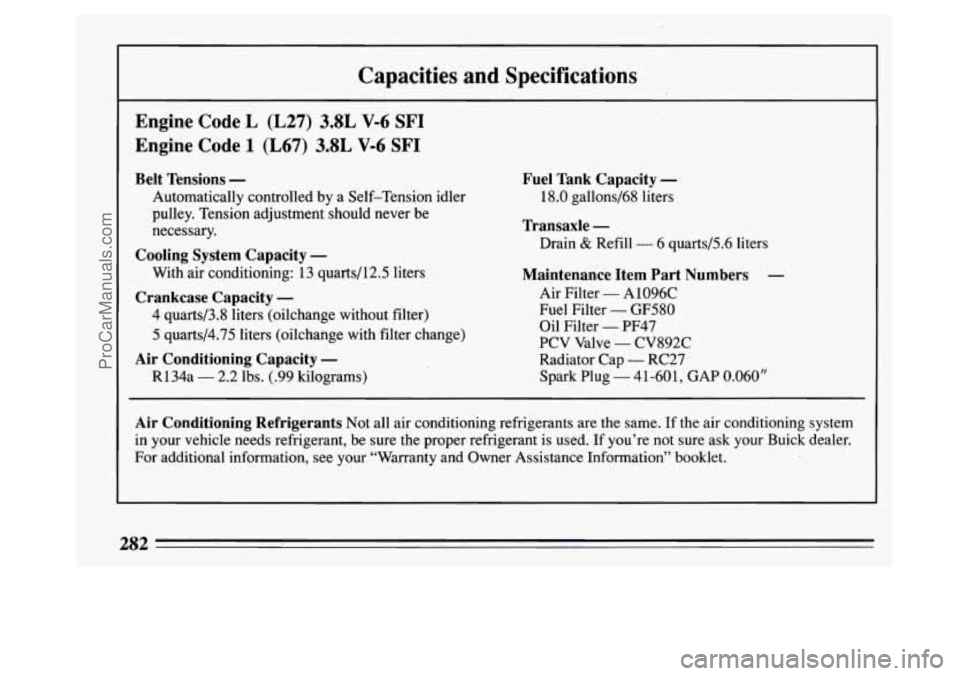
Capacities and Specifications
~~~ ~ ~~~~~
Engine Code L (L27) 3.8L V-6 SF1
Engine Code 1 (L67) 3.8L V-6 SF1
Belt Tensions -
Automatically controlled by a Self-Tension idler
pulley. Tension adjustment should never be
necessary.
Cooling System Capacity -
Crankcase Capacity -
With air conditioning: 13 quarts/l2.5 liters
4 quarts/3.8 liters (oilchange without filter) 5 quarts/4.75 liters (oilchange with filter change)
R134a
- 2.2 lbs. (.99 kilograms)
Air Conditioning Capacity -
Fuel Tank Capacity -
18.0 gallons/68 liters
Transaxle -
Drain & Refill - 6 quarts/5.6 liters
Maintenance Item Part Numbers -
Air Filter - A 1096C
Fuel Filter - GF580
Oil Filter
- PF47
PCV Valve
- CV892C
Radiator Cap
- RC27
Spark Plug
- 41-601, GAP 0.060”
Air Conditioning Refrigerants Not all air conditioning refrigerants are the same. If the air conditioning system
in your vehicle needs refrigerant, be sure the proper refrigerant is used. If you’re not sure ask your Buick dealer.
For additional information, see your “Warranty and Owner Assistance Information” booklet.
ProCarManuals.com
Page 286 of 324
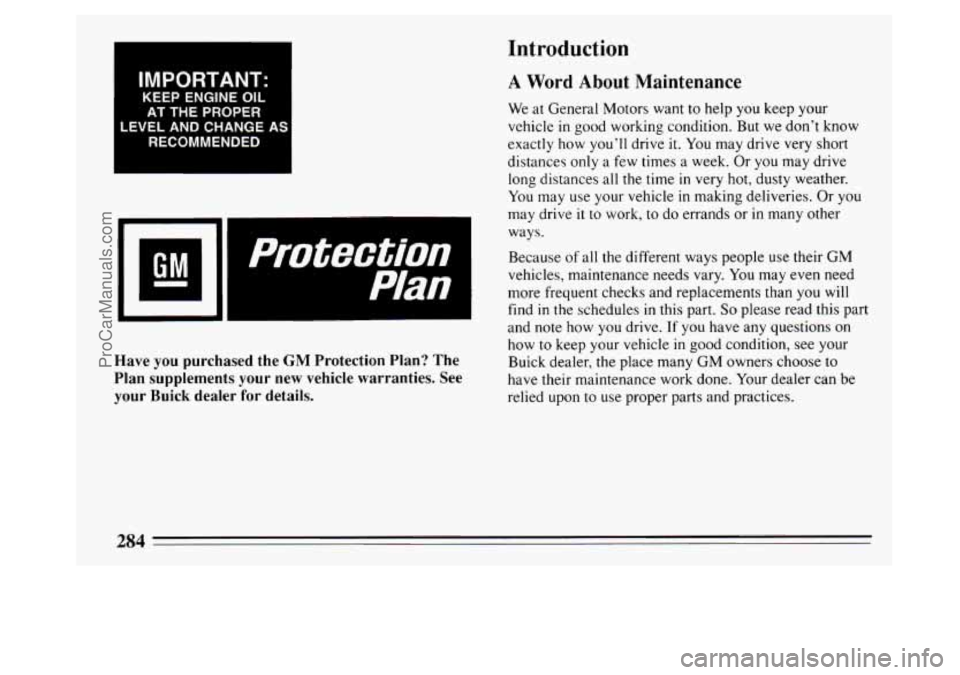
I IMPORTANT: I
KEEP ENGINE OIL
AT THE PROPER
LEVEL AND CHANGE AS
RECOMMENDED
11
protection I
Have you purchased the GM Protection Plan? The
Plan supplements your new vehicle warranties. See
your Buick dealer for details.
Introduction
A Word About Maintenance
We at General Motors want to help you keep your
vehicle in good working condition. But we don’t know
exactly how you’ll drive
it. You may drive very short
distances only a few times a week. Or you may drive
long distances all the time
in very hot, dusty weather.
You
may use your vehicle in making deliveries. Or you
may drive
it to work, to do errands or in many other
ways.
Because
of all the different ways people use their GM
vehicles, maintenance needs vary. You may even need
more frequent checks and replacements than you
will
find in the schedules in this part. So please read this part
and note how you drive.
If you have any questions on
how to keep your vehicle in good condition, see your
Buick dealer,
the place many GM owners choose to
have their maintenance work done. Your dealer can be
relied upon to use proper parts and practices.
284
ProCarManuals.com
Page 292 of 324
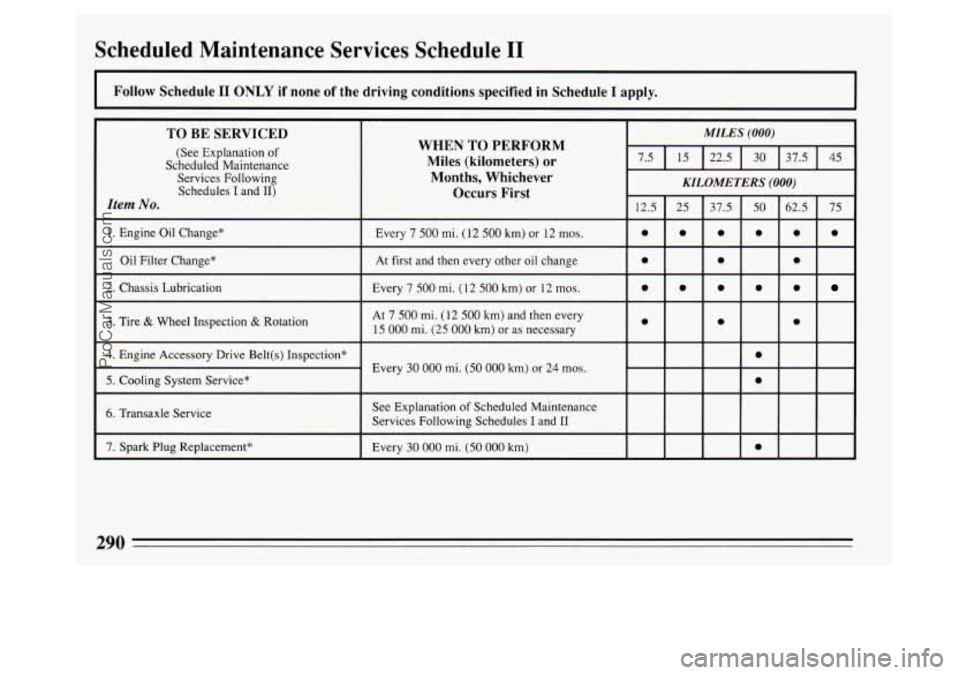
Scheduled Maintenance Services Schedule I1
I Follow Schedule I1 ONLY if none of the driving conditions specified in Schedule I apply.
TO BE SERVICED
(See Explanation of
Scheduled Maintenance
Services Following
Schedules I and 11)
Item No.
1. Engine Oil Change*
Oil Filter Change*
2. Chassis Lubrication
3. Tire
& Wheel Inspection & Rotation
4. Engine Accessory Drive Belt(s) Inspection*
5. Cooling System Service*
6. Transaxle Service
7. Spark Plug Replacement*
WHEN TO PERFORM
Miles (kilometers) or
Months, Whichever
Occurs First
MILES (000)
KILOMETERS (000)
I I 12.5 I 25
Every
7 500 mi. (12 500 km) or 12 mos. PIo
At first and then every other oil change
Every
7 500 mi. ( 12 500 km) or 12 mos.
At 7 500 mi. ( 12 500 km) and then every
15 000 mi. (25 000 km) or as necessary
Every
30 000 mi. (50 000 km) or 24 mos.
See Explanation of Scheduled Maintenance
Services Following Schedules I and I1
Every
30 000 mi. (50 000 km) 37.5
50 62.5
0 0 0
0 0
0 0 0
0 0
0
0
0
290
ProCarManuals.com
Page 294 of 324
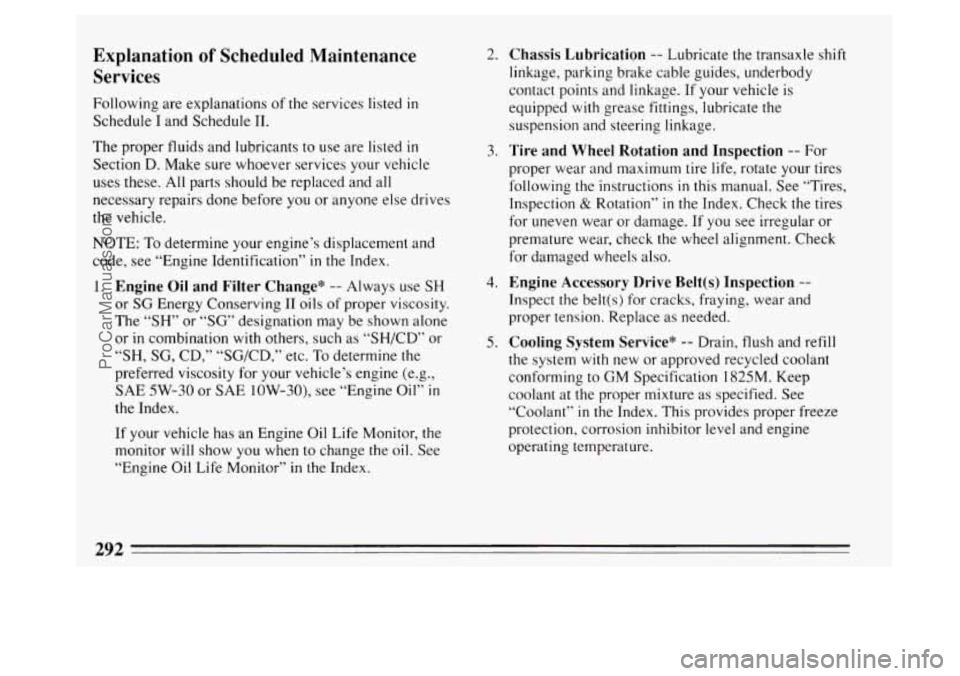
Explanation of Scheduled Maintenance
Services
Following are explanations of the services listed in
Schedule I and Schedule 11.
The proper fluids and lubricants to use are listed
in
Section D. Make sure whoever services your vehicle
uses these. All parts should be replaced and all
necessary repairs done before you or anyone else drives
the vehicle.
NOTE: To determine your engine’s displacement and
code, see “Engine Identification”
in the Index.
1. Engine Oil and Filter Change* -- Always use SH
or SG Energy Conserving I1 oils of proper viscosity.
The
“SH” or “SG” designation may be shown alone
or
in combination with others, such as “SH/CD” or
“SH,
SG, CD,” “SG/CD,” etc. To determine the
preferred viscosity for your vehicle’s engine (e.g., SAE
5W-30 or SAE low-30), see “Engine Oil” in
the Index.
If your vehicle has an Engine Oil Life Monitor, the
monitor will show you when to change the oil. See
“Engine Oil Life Monitor”
in the Index. 2.
Chassis Lubrication -- Lubricate
the transaxle shift
linkage, parking brake cable guides, underbody
contact points and linkage. If your vehicle is
equipped
with grease fittings, lubricate the
suspension and steering linkage.
3. Tire and Wheel Rotation and Inspection -- For
proper wear and maximum tire life, rotate your tires
following the instructions
in this manual. See “Tires,
Inspection
& Rotation” in the Index. Check the tires
for uneven wear or damage. If you see irregular or
premature wear, check the wheel alignment. Check
for damaged wheels also.
4. Engine Accessory Drive Belt(s) Inspection --
Inspect the belt(s) for cracks, fraying, wear and
proper tension. Replace as needed.
5. Cooling System Service* -- Drain, flush and refill
the system
with new or approved recycled coolant
conforming to GM Specification 1825M. Keep
coolant at the proper mixture as specified. See
“Coolant”
in the Index. This provides proper freeze
protection, corrosion inhibitor level and engine
operating temperature.
292
ProCarManuals.com
Page 295 of 324
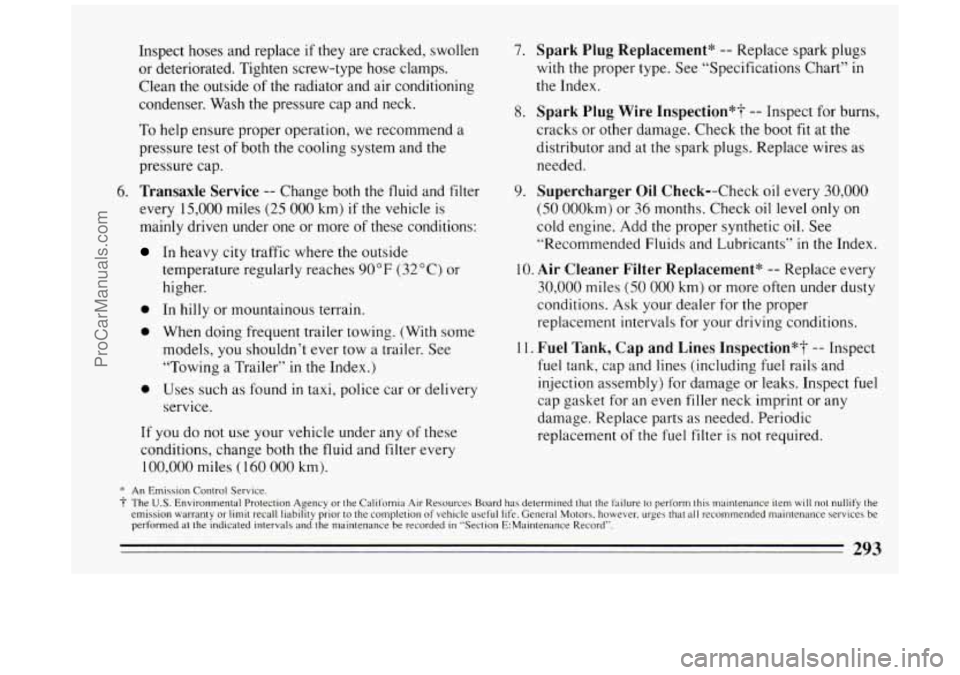
Inspect hoses and replace if they are cracked, swollen
or deteriorated. Tighten screw-type hose clamps.
Clean the outside of the radiator and air conditioning
condenser. Wash the pressure cap and neck.
To help ensure proper operation, we recommend a
pressure test of both the cooling system and the
pressure cap.
6.
Transaxle Service -- Change both the fluid and filter
every
15,000 miles (25 000 km) if the vehicle is
mainly driven under one or more
of these conditions:
In heavy city traffic where the outside
temperature regularly reaches
90°F (32°C) or
higher.
0 In hilly or mountainous terrain.
0 When doing frequent trailer towing. (With some
models, you shouldn’t ever tow a trailer. See
“Towing a Trailer”
in the Index.)
0 Uses such as found in taxi, police car or delivery
service.
If you do not use your vehicle under any of these
conditions, change both the fluid and filter every
100,000 miles ( 160 000 km).
7. Spark Plug Replacement* -- Replace spark plugs
with the proper type. See “Specifications Chart”
in
the Index.
8. Spark Plug Wire Inspection*-f -- Inspect for burns,
cracks or other damage. Check the boot
fit at the
distributor and at the spark plugs. Replace wires as
needed.
9. Supercharger Oil Check--Check oil every 30,000
(50 000km) or 36 months. Check oil level only on
cold engine. Add the proper synthetic oil. See
“Recommended Fluids and Lubricants” in the Index.
10. Air Cleaner Filter Replacement* -- Replace every
30,000 miles (50 000 km) or more often under dusty
conditions. Ask your dealer for the proper
replacement intervals for your driving conditions.
1 1. Fuel Tank, Cap and Lines Inspection*? -- Inspect
fuel tank, cap and lines (including fuel rails and
injection assembly) for damage or leaks. Inspect fuel
cap gasket for an even filler neck imprint or any
damage. Replace parts as needed. Periodic
replacement
of the fuel filter is not required.
* An Emission Control Service.
-f The US. Environmental Protection Agency or the California Air Resources Board has determined that the failure to perform this maintenance item will not nullify the
emission warranty or limit recall liability prior to the completion of vehicle useful life. General Motors. however. urges that all recommended maintenance services be
performed at the indicated intervals and the maintenance be recorded in “Section E:Maintenance Record”.
293
ProCarManuals.com